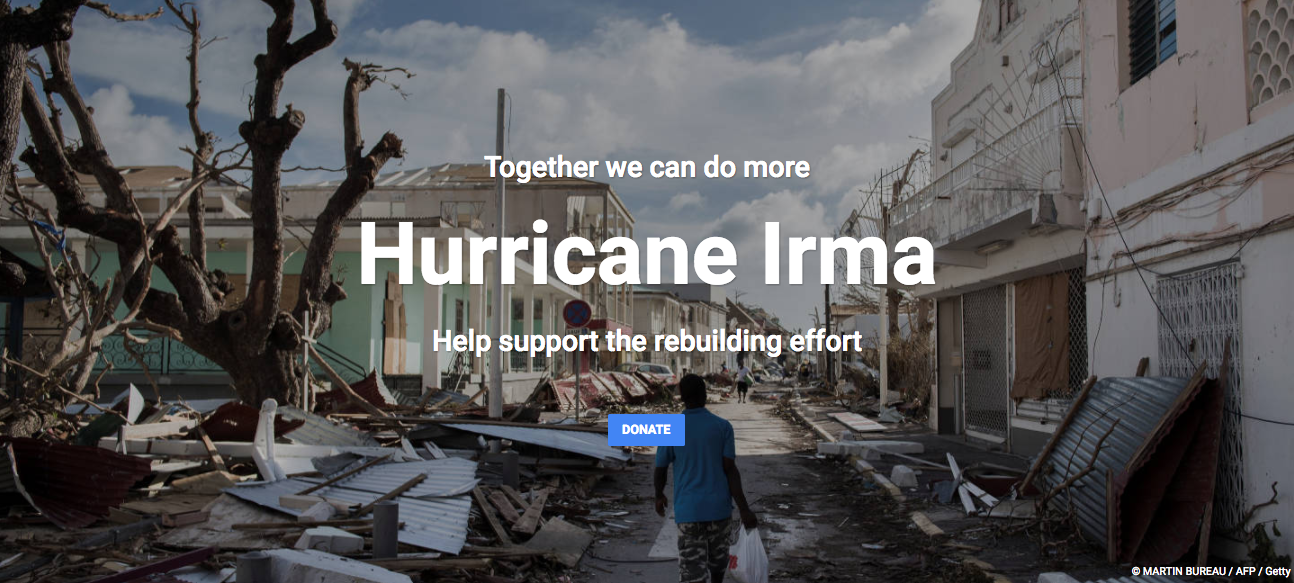Tag Archives: crisis response
Supporting those affected by the California fires
Fueled by high winds, fast-moving wildfires in the California wine country and the Anaheim Hills have spread quickly—killing dozens, damaging tens of thousands of acres, destroying infrastructure, forcing evacuations, and leaving hundreds of people unaccounted for.
Like many people in the Bay Area, my first news of the North Bay fires was the smell of smoke Monday morning. My thoughts immediately turned to my family and childhood home in Santa Rosa. My family was safe, but I raced up to Petaluma to see how I could help. In addition to needed resources on the ground, I saw how centralized information can be crucial to help people find shelter and other resources.
SOS Alerts and Fire Information
On Monday, the Crisis Response team launched an SOS Alert—a set of features in Google Search and Maps that helps you quickly understand what’s going on and decide what to do during a crisis. After launching the Alert, the Crisis Response team created a Crisis Map with shelter locations, vacancy status, pet accommodations and shelter needs, crowdsourced via waze.com, local volunteers, and Googlers such as myself. The map has been updated to include recent satellite imagery for the North Bay area as well.
In addition to these map-based resources, the team has pushed out air-quality resources via Google Feed, with information from the Bay Area Air Quality Management District and American Lung association.
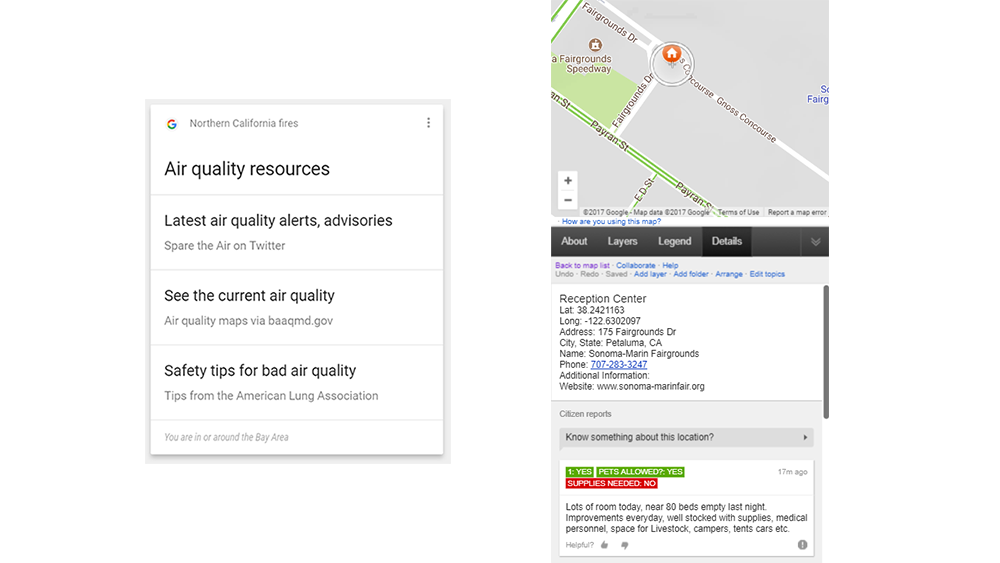
$1 million for fire relief and recovery
To help with the relief and recovery in California, Google.org and Googlers are committing $1 million in donations to organizations that are providing critical resources in the affected regions. To support immediate needs, we’re distributing funds to the Redwood Empire Food Bank and the Red Cross. We’re also supporting the Napa Valley Community Foundation, the Community Foundation Sonoma County, and the Latino Community Foundation, which are coordinating the longer-term fire recovery initiatives.
Google.org will support these organizations and others to identify ways Google volunteers can bring value to the affected areas. Right now, we’re in discussions with the Information Technology Disaster Resource Center and have sent a team of technical Googler volunteers to assess the connectivity needs of first responders and evacuees.
Efforts on the ground
Google Express is also providing in-kind donations of ready-to-eat, non-perishable foods to benefit the Redwood Empire Food Bank. And Google’s food team will partner with Off the Grid to provide more than 25,000 meals via food trucks to Napa and Sonoma County shelters over the next month.
My hometown of Santa Rosa is one of many that has been devastated, and the fires are still active in Northern California and the Anaheim Hills. As the situation progresses, Google will continue to update the Crisis Map and SOS alerts to help deliver the most up-to-date information available. My thoughts are with the North Bay community and others that have been impacted by recent natural disasters around the world.
Source: The Official Google Blog
Supporting those affected by the California fires
Fueled by high winds, fast-moving wildfires in the California wine country and the Anaheim Hills have spread quickly—killing dozens, damaging tens of thousands of acres, destroying infrastructure, forcing evacuations, and leaving hundreds of people unaccounted for.
Like many people in the Bay Area, my first news of the North Bay fires was the smell of smoke Monday morning. My thoughts immediately turned to my family and childhood home in Santa Rosa. My family was safe, but I raced up to Petaluma to see how I could help. In addition to needed resources on the ground, I saw how centralized information can be crucial to help people find shelter and other resources.
SOS Alerts and Fire Information
On Monday, the Crisis Response team launched an SOS Alert—a set of features in Google Search and Maps that helps you quickly understand what’s going on and decide what to do during a crisis. After launching the Alert, the Crisis Response team created a Crisis Map with shelter locations, vacancy status, pet accommodations and shelter needs, crowdsourced via waze.com, local volunteers, and Googlers such as myself. The map has been updated to include recent satellite imagery for the North Bay area as well.
In addition to these map-based resources, the team has pushed out air-quality resources via Google Feed, with information from the Bay Area Air Quality Management District and American Lung association.

$1 million for fire relief and recovery
To help with the relief and recovery in California, Google.org and Googlers are committing $1 million in donations to organizations that are providing critical resources in the affected regions. To support immediate needs, we’re distributing funds to the Redwood Empire Food Bank and the Red Cross. We’re also supporting the Napa Valley Community Foundation, the Community Foundation Sonoma County, and the Latino Community Foundation, which are coordinating the longer-term fire recovery initiatives.
Google.org will support these organizations and others to identify ways Google volunteers can bring value to the affected areas. Right now, we’re in discussions with the Information Technology Disaster Resource Center and have sent a team of technical Googler volunteers to assess the connectivity needs of first responders and evacuees.
Efforts on the ground
Google Express is also providing in-kind donations of ready-to-eat, non-perishable foods to benefit the Redwood Empire Food Bank. And Google’s food team will partner with Off the Grid to provide more than 25,000 meals via food trucks to Napa and Sonoma County shelters over the next month.
My hometown of Santa Rosa is one of many that has been devastated, and the fires are still active in Northern California and the Anaheim Hills. As the situation progresses, Google will continue to update the Crisis Map and SOS alerts to help deliver the most up-to-date information available. My thoughts are with the North Bay community and others that have been impacted by recent natural disasters around the world.
Source: Search
Providing support to those affected by Hurricane Maria
Hurricane Maria recently made landfall in Puerto Rico as a Category 4 hurricane, killing at least 10 people and leaving much of the island without power or water. Elsewhere in the Caribbean, millions more are looking to rebuild—the storm destroyed the island of Dominica, killing at least 15 people, and devastated the Dominican Republic, the U.S. Virgin Islands, and Turks and Caicos.
I was born and raised outside of San Juan, in a town called Cupey, and left the island to study in the States. Today, I still have family there, as well as in Barranquitas, towards the center of the island. The roof broke off my grandmother's terrace, a place filled with many memories of family gatherings growing up. My uncles, who are agricultural entrepreneurs in Barranquitas, were able to visit their land just yesterday and see the damage caused to their crops, completely turning their business upside down. I'm lucky that my family members are all safe, but the damage will still take years to repair.
To help with the relief and recovery in Puerto Rico and beyond, Google.org and Googlers are committing $1 million in donations to organizations that are providing critical resources to the affected regions. To support immediate humanitarian needs, we’re distributing funds to organizations including the Red Cross, World Food Program, and UNICEF. We’re also supporting NetHope, which provides Internet access in the wake of natural disasters around the world, because connectivity can be a critical link in providing basic needs like food, water and medical care. This month has taxed the resources of first responder agencies across the region, and we want to make sure nonprofits like NetHope have the resources they need to respond to Hurricane Maria. We’ve also had a small team of engineers volunteer in the wake of recent Hurricanes Harvey and Irma, to help restore connectivity by setting up hot-spots and assisting with other technical needs that local nonprofits and shelters may have. We’re working with NetHope to find ways that our technical volunteers can be most helpful in Puerto Rico as well.
Crisis Response and SOS Alerts
In times of crises, having access to timely safety information can be critical. Ahead of the storm, Google’s Crisis Response team launched SOS Alerts for Hurricane Maria. Although few people have connectivity in the storm’s wake, we’ve continued to update the alert with information on power outages, emergency information contacts, the damage to the Guajataca dam, and crisis maps in both English and Spanish. Those outside of the region can also find the latest news and information, as well as an easy way to donate to relief efforts, directly through Search.
As the 2017 hurricane season has pummeled the U.S. and the Caribbean, Google.org, Google employees and the public have collectively donated $7 million for relief efforts in the areas affected by Harvey, Irma and Maria. My thoughts are with everyone in Puerto Rico and other affected areas, and it gives me solace to know that my colleagues and company are doing everything they can to help.
Source: The Official Google Blog
Providing support to those affected by Hurricane Maria
Hurricane Maria recently made landfall in Puerto Rico as a Category 4 hurricane, killing at least 10 people and leaving much of the island without power or water. Elsewhere in the Caribbean, millions more are looking to rebuild—the storm destroyed the island of Dominica, killing at least 15 people, and devastated the Dominican Republic, the U.S. Virgin Islands, and Turks and Caicos.
I was born and raised outside of San Juan, in a town called Cupey, and left the island to study in the States. Today, I still have family there, as well as in Barranquitas, towards the center of the island. The roof broke off my grandmother's terrace, a place filled with many memories of family gatherings growing up. My uncles, who are agricultural entrepreneurs in Barranquitas, were able to visit their land just yesterday and see the damage caused to their crops, completely turning their business upside down. I'm lucky that my family members are all safe, but the damage will still take years to repair.
To help with the relief and recovery in Puerto Rico and beyond, Google.org and Googlers are committing $1 million in donations to organizations that are providing critical resources to the affected regions. To support immediate humanitarian needs, we’re distributing funds to organizations including the Red Cross, World Food Program, and UNICEF. We’re also supporting NetHope, which provides Internet access in the wake of natural disasters around the world, because connectivity can be a critical link in providing basic needs like food, water and medical care. This month has taxed the resources of first responder agencies across the region, and we want to make sure nonprofits like NetHope have the resources they need to respond to Hurricane Maria. We’ve also had a small team of engineers volunteer in the wake of recent Hurricanes Harvey and Irma, to help restore connectivity by setting up hot-spots and assisting with other technical needs that local nonprofits and shelters may have. We’re working with NetHope to find ways that our technical volunteers can be most helpful in Puerto Rico as well.
Crisis Response and SOS Alerts
In times of crises, having access to timely safety information can be critical. Ahead of the storm, Google’s Crisis Response team launched SOS Alerts for Hurricane Maria. Although few people have connectivity in the storm’s wake, we’ve continued to update the alert with information on power outages, emergency information contacts, the damage to the Guajataca dam, and crisis maps in both English and Spanish. Those outside of the region can also find the latest news and information, as well as an easy way to donate to relief efforts, directly through Search.
As the 2017 hurricane season has pummeled the U.S. and the Caribbean, Google.org, Google employees and the public have collectively donated $7 million for relief efforts in the areas affected by Harvey, Irma and Maria. My thoughts are with everyone in Puerto Rico and other affected areas, and it gives me solace to know that my colleagues and company are doing everything they can to help.
Source: Search
Continuing to support hurricane relief efforts
Hurricane Irma has impacted communities throughout the Caribbean and the southeastern United States. Hitting the Caribbean islands the hardest, Irma has left millions of people to rebuild in its wake.
Today, we’re kicking off a matching campaign to support relief and recovery efforts for this deadly storm, part of our overall $5 million hurricane relief effort this month.
Google.org will be matching up to $1 million in donations at https://www.google.org/irma-relief to support the Catholic Relief Service (CRS), UNICEF, and the American Red Cross (ARC).Each of these organizations is providing critical relief and recovery resources to those in the affected regions:
- Catholic Relief Services is responding to the most remote places across the Caribbean, fulfilling essential needs such as food, water and shelter.
- UNICEF is on the ground supporting more than 2.8 million children, and their families, impacted across the Caribbean with emergency supplies and temporary education solutions.
- American Red Cross is the leading nonprofit responder in the Southeastern United States, Puerto Rico and the U.S. Virgin Islands, working diligently to shelter, feed and support families impacted by the storm.
Crisis Response and SOS Alerts
Ensuring people have access to timely, official information in a time of crisis is crucial. To help, ahead of the storm, our Crisis Response team launched an SOS Alert in Search for the Caribbean, Florida and Georgia in English, Spanish and Haitian Creole. Now, as people across the region return to their homes and search for information about Hurricane Irma, or related searches, they’ll see:
- Information on power outages
- Emergency information contacts
- Crisis maps in both English and Spanish, providing people with the local news, road closures, tweets, latest traffic and transit information, gas stations with crowdsourced fuel status, and post-Irma satellite and aerial imagery from partners NOAA and Digital Globe (e.g., Key West).
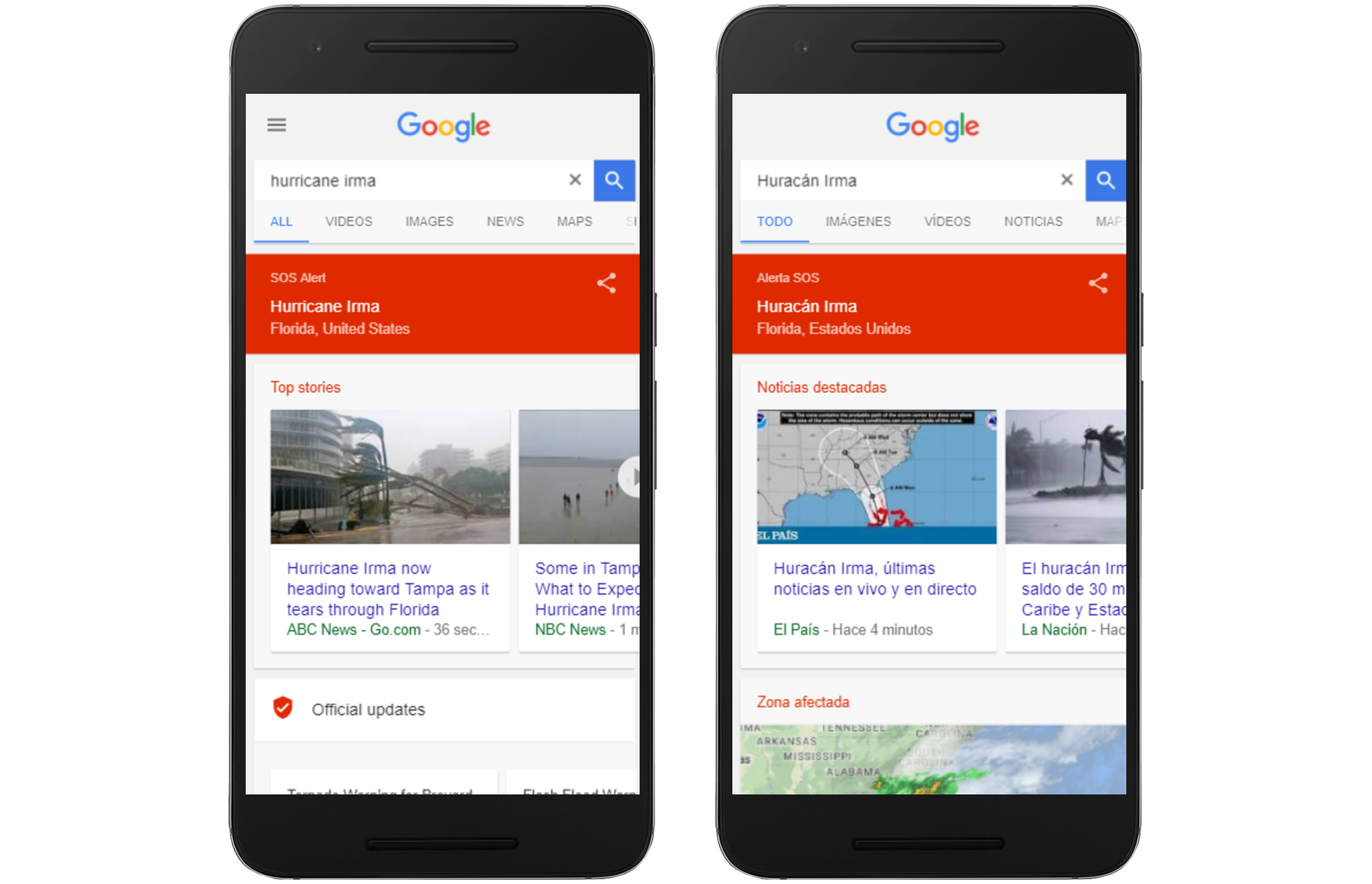
We hope these features will help people stay safe and informed—and we’ll continue to update with relevant resources in the coming days.
Source: The Official Google Blog
Continuing to support hurricane relief efforts
Update: In less than 24 hours, together we raised $2 million for Hurricane Irma relief and recovery. Thanks to your donations, we have met our goal. However, the crisis isn’t over. Your contributions can still provide critical relief to those in need. Although Google is no longer matching donations, please consider giving directly to these organizations.
Hurricane Irma has impacted communities throughout the Caribbean and the southeastern United States. Hitting the Caribbean islands the hardest, Irma has left millions of people to rebuild in its wake.
Today, we’re kicking off a matching campaign to support relief and recovery efforts for this deadly storm, part of our overall $5 million hurricane relief effort this month.
Google.org will be matching up to $1 million in donations at https://www.google.org/irma-relief to support the Catholic Relief Service (CRS), UNICEF, and the American Red Cross (ARC).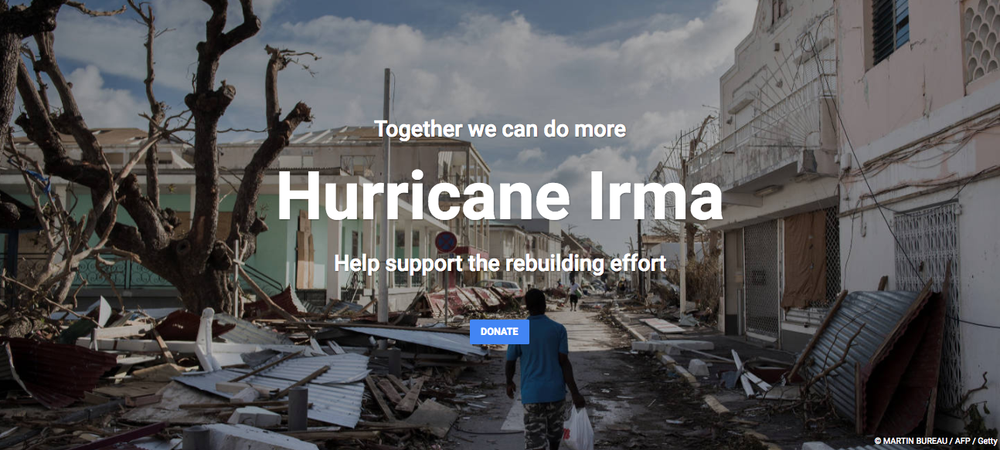
Each of these organizations is providing critical relief and recovery resources to those in the affected regions:
- Catholic Relief Services is responding to the most remote places across the Caribbean, fulfilling essential needs such as food, water and shelter.
- UNICEF is on the ground supporting more than 2.8 million children, and their families, impacted across the Caribbean with emergency supplies and temporary education solutions.
- American Red Cross is the leading nonprofit responder in the Southeastern United States, Puerto Rico and the U.S. Virgin Islands, working diligently to shelter, feed and support families impacted by the storm.
Crisis Response and SOS Alerts
Ensuring people have access to timely, official information in a time of crisis is crucial. To help, ahead of the storm, our Crisis Response team launched an SOS Alert in Search for the Caribbean, Florida and Georgia in English, Spanish and Haitian Creole. Now, as people across the region return to their homes and search for information about Hurricane Irma, or related searches, they’ll see:
- Information on power outages
- Emergency information contacts
- Crisis maps in both English and Spanish, providing people with the local news, road closures, tweets, latest traffic and transit information, gas stations with crowdsourced fuel status, and post-Irma satellite and aerial imagery from partners NOAA and Digital Globe (e.g., Key West).
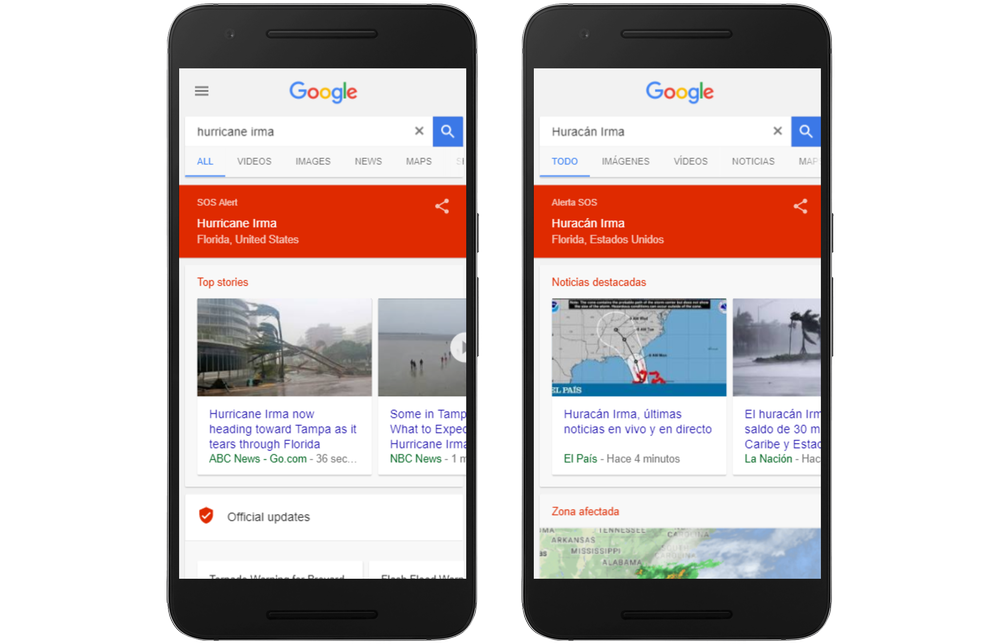
We hope these features will help people stay safe and informed—and we’ll continue to update with relevant resources in the coming days.
Source: The Official Google Blog
Helping people stay informed and connected in Japan and Ecuador
Find and call loved ones
To help people post and search for family or friends affected by the disaster we activated Person Finder in Spanish and Japanese. We’re also offering free calls via Hangouts, Hangouts Dialer or Google Voice to and within Ecuador to help people communicate with loved ones.
Learn more on the ground
For people in and around the affected areas, we have Google Now cards with critical crisis-related information like missing person resources, safety zones, and aftershock safety tips. We’ve made the same information available on search for earthquake-related searches. In Japan, we launched a landing page and crisis map showing accessible roads and places where people can get disaster resources like fresh water. In Ecuador, we updated Waze with more than 90 safe place locations, including local shelter information.
Support for the response
Given the scope of the damage and need in Ecuador, Google.org has committed $250,000 to support relief efforts on the ground. We’re also providing up to $250,000 in Google employee gift-matching for both Japan and Ecuador.
Source: The Official Google Blog
Search on: 2015 in Google Search
From devastation to empowerment and tragedy to hope, our 15th annual Year in Search uncovers the moments that captured the world’s hearts—and questions that revealed who we are. From “How can I help Nepal” to “How can the world find peace?” here’s a look back at 2015, through the lens of Google search.
Searching for ways to help
Within two minutes of the deadly attack on Paris in November, the French capital was searching for information on the assault underway in their city. Less than 10 minutes later, the rest of the world started searching. As of today, we’ve seen more than 897 million searches about the city as the world came together to “Pray for Paris.”
Global showings of support and offerings of help were a key topic in search this year. Following the Nepal earthquake, “how can I help Nepal?” was a top global search. From Somerville, Mass. to Ludwigsberg, Germany, people asked how to volunteer and what to donate.
Searching for perspective
While questions around Nepal were similar around the world, the migrant crisis in Europe spiked a wider variety of queries. From Italy asking “How to adopt a Syrian orphan child?” to Germany wondering “Where are the refugees coming from?” the world turned to Google to understand the situation and what it meant for them.
In the U.S., the topic of guns brought varying questions. From Portland, Ore. to Austin, Texas, people across the country searched for “what is gun control,” “why do we need gun control,” “why won’t gun control work” and more to understand the issue. With more than 160 million searches, interest in gun control spiked higher than interest for gun shops—typically a more popular search—at multiple points in 2015.
Searching for acceptance
In June, we met Caitlyn Jenner, someone we’d both always known and were meeting for the first time. Across the globe, she was searched more than 344 million times, and her story helped give a new voice to the transgender community.
People cheered “#lovewins” when the U.S. Supreme Court made a monumental ruling that gay marriages should be recognized at both the State and Federal level. The reaction was instant, with search interest in both same-sex marriage and the Supreme Court reaching higher than at any time in Google's history.
Searching for… the dress, the Force and the singer
Turning to the Search watercooler, the year began with the world divided over an important question: is it white and gold? or blue and black? Days of debate and 73 million searches later, “black and blue dress” topped searches of “white and gold dress,” and the matter was settled forever (right?).
And though “Star Wars: The Force Awakens” is just hitting theaters this week, it’s already taken the Internet by storm(trooper). The trailer alone garnered more than 155 million searches! But the all-time high for Google searches around “Star Wars” was in 2005 after “The Revenge of the Sith” came out in theaters—can we beat it this week?
Finally, what better way to close out the year than by saying “Hello”? With the debut of “25,” Adele broke records by the week, putting her album at the top of the charts and skyrocketing to the top of Google Search faster than any other musician this year.
Hundreds of stories in depth
The 2015 Year in Search goes deeper than we've ever gone before. This year, we’re covering hundreds of news stories, sharing interactive guides and charts, and diving into the numbers by sharing things like how many times people searched for Adele (439 million, if you want to know!).
Go to Google.com/2015 to explore the rest of the 2015 Year in Search stories and top trending charts from around the world.
